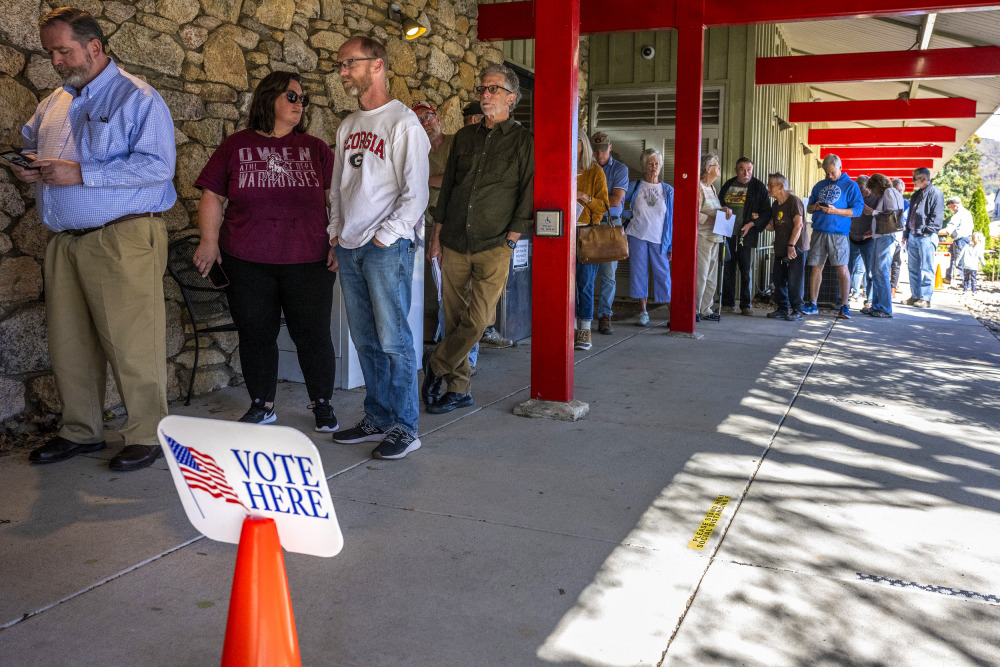
This article is more than
9 year oldNot since a surge in the polls at the end of the Republican National Convention two months ago has Donald Trump been this close to winning the White House. But Trump has less margin for error than his Democratic rival, as his lead over Hillary Clinton in a number of swing states is slim.
According to the CBC's Presidential Poll Tracker, Clinton is currently averaging 44.7 per cent support among decided voters, compared with 42.8 per cent for Trump. The edge Clinton continues to hold over Trump has diminished rapidly — standing at well over six points in August and a little more than three points two weeks ago. That lead now sits at just 1.9 points.
While Clinton was already trending downward, the combined impact of her "deplorables" comment and her health issues surrounding a diagnosis of pneumonia may have contributed to her numbers dropping further. In polls conducted since her near collapse at a Sept. 11 commemoration, Clinton has averaged a lead of 1.3 points over Trump. Those same pollsters had her ahead by 2.2 points during the previous two weeks.
Polling by Morning Consult suggests that Clinton's health issues may be a problem for her. While the survey found that 70 per cent of respondents considered Trump's health to be average or better, just 50 per cent thought the same thing for Clinton.
And though 49 per cent of respondents said her health issues had no influence on their voting intentions, 24 per cent said it made them less likely to cast a ballot for Clinton, including a tenth of self-identified Democrats and a quarter of independents.
In a tight contest, those are important numbers. And the unsuitability of the other person will likely continue to be the focus of each campaign. Arecent Angus Reid Institute survey found that about half of Clinton and Trump supporters are voting for their candidate primarily to keep the other candidate out of the White House.
Clinton's lead in the electoral college has also narrowed considerably. From 341 projected votes two weeks ago, Clinton is now projected to win 303 electoral college votes, with Trump taking 235. If Trump wins all of the current swing states, he could take as many as 299 votes. He needs 270 to become the next president.
At the moment, all that stands between Trump and the White House are two states: Florida and North Carolina, whose combined 44 electoral college votes are enough to swing the election to the Republican candidate.
In both of these states, Clinton is currently projected to be leading by a very narrow margin. Four of the six most recent polls in Florida put the gap at three points or less. In North Carolina, the last three polls have all put the margin at two points or less.
It would not take much to push Trump over the top in Florida and North Carolina and into the White House. But this assumes he can hold on to the other swing states in which he leads.
In Colorado, Nevada and Ohio, Trump is currently projected to be ahead of Clinton by two points or less.
While Nevada has been a toss-up state for months, Colorado and Ohio have been trending toward Trump. He has led in four of the last six polls in Ohio, turning a state in which Clinton led by an average of three points in August into one where Trump is able to put up five-point leads in individual polls.
(Trump is also projected to be ahead in New Mexico, but this is largely due to a recent Ipsos/Reuters poll that appears out of step with earlier surveys done in the state. Future polling will determine whether or not this small-sample poll is an outlier.)
These states give Clinton some options in putting together an electoral map that excludes Florida and North Carolina. But the danger for Clinton is that states tend to move together — if she is losing Florida and North Carolina on Nov. 8, she is unlikely to be pulling ahead in other swing states.
But other options do exist for both candidates. Trump could make a play for the Democratic-leaning Northeast and Midwest, where the polls are getting tighter in such states as Maine and Michigan. Conversely, Clinton could try to make a play for the South, holding Florida and North Carolina and moving ahead in Georgia, where polls continue to show smaller-than-expected margins.

That these electoral calculations are being made once again demonstrates just how competitive this contest has become. Little over a month ago, Clinton held wide leads in enough states to put her over the 270-mark comfortably. At this stage of the 2008 and 2012 campaigns, Barack Obama was enjoying wider leads over his Republican opponents than Clinton is today.
She's still in front and still the favourite to win. Trump's numbers may fade, as they have done before. But the likelihood of a Trump White House, with the election fast approaching, has never looked greater.
The Presidential Poll Tracker includes all published mainstream surveys, a list of which can be found here. The polls are weighted by sample size and date, as well as the reliability of each pollster as rated by FiveThirtyEight.com. The electoral college is projected by applying the same weighting standards to state-level polls and combining this with a uniform swing model, based on how the current national polling average compares with the 2012 presidential election. Surveys included in the model vary in terms of sample size and methodology and have not been individually verified by the CBC. A full methodological explanation can be found here.